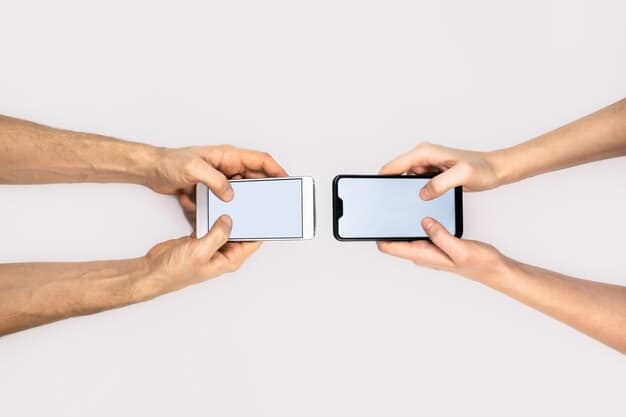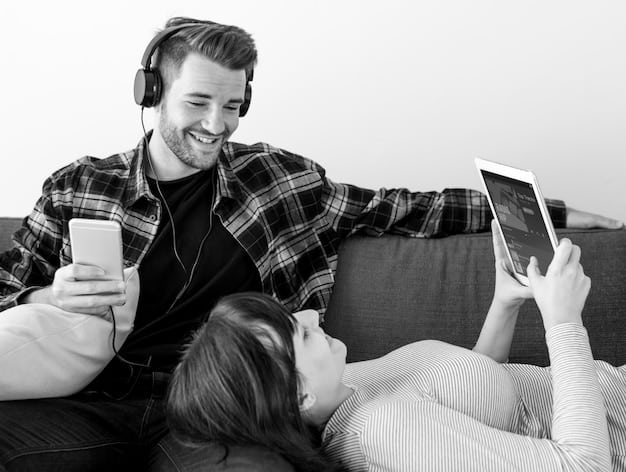Social Media & Intimacy: Reclaiming Connection in 2025

Social media platforms deeply influence personal relationships, and maintaining a healthy digital balance is crucial in 2025 to safeguard and enhance intimacy.
In an increasingly digitized world, the lines between our online and offline lives have blurred, often impacting our most personal connections. Recognizing Is Social Media Impacting Your Intimacy? Strategies for a Healthier Digital Balance in 2025 becomes paramount for fostering stronger, more meaningful relationships.
The Digital Veil: How Social Media Reshapes Intimacy
The pervasive influence of social media has subtly yet profoundly begun to reshape the very fabric of intimacy. What once was a private, shared space between individuals now faces the constant potential intrusion of notifications, curated online personas, and the endless scroll. This digital veil can create a sense of presence that is simultaneously distant, making genuine connection feel elusive even when physically together.
Social media platforms, designed for constant engagement, inadvertently foster habits that can erode the foundations of intimate relationships. The dopamine rush associated with likes, comments, and shares can make checking a phone more appealing than engaging in a heartfelt conversation. This shift in attention, often imperceptible at first, gradually accumulates, creating a void where shared moments and deep emotional exchanges should thrive. The constant sharing of intimate details with a broader audience also redefines the boundaries of privacy, fundamentally altering the dynamic of a relationship from one of exclusivity to one of performative sharing.
Erosion of Face-to-Face Connection
One of the most immediate impacts is on the quality of face-to-face interactions. When a partner’s attention is frequently diverted to their phone, opportunities for deep engagement, non-verbal cues, and shared laughter diminish. This constant partial attention can leave individuals feeling unheard and unimportant, leading to a sense of disconnect.
- Reduced Eye Contact: Phones often draw gaze away during conversations.
- Fragmented Dialogue: Notifications interrupt natural conversational flow.
- Lost Spontaneity: Moments of unplanned connection are often missed due to digital distraction.
The Performance of a Relationship
Social media often transforms personal relationships into public performances. Couples may feel pressure to present an idealized version of their intimacy, focusing on “couple goals” photos and public declarations of love rather than nurturing the relationship privately. This emphasis on external validation can shift the focus from genuine connection to maintaining an image. Such superficial interactions drain energy that could otherwise be invested in real-world relationship building, making it harder to address underlying issues or simply enjoy quiet, private moments. The constant comparison with other couples’ “highlight reels” can also breed insecurity and dissatisfaction within one’s own partnership.
The subtle pressures of social media extend even to how couples spend their leisure time. Instead of simply enjoying a meal or a walk together, there’s often an underlying urge to capture the “perfect” photo or story, interrupting the natural flow of the experience. This constant awareness of an external audience can make it difficult for partners to truly relax and be themselves, leading to a feeling of being perpetually “on.” The pursuit of online validation thus inadvertently displaces the pursuit of authentic, shared experiences, diluting the depth of intimacy.
The Green-Eyed Monster: Social Comparison and Jealousy
Social media’s curated realities often paint an incomplete, idealized picture of others’ lives and relationships. This constant exposure to seemingly perfect partnerships, often showcasing exotic vacations or grand romantic gestures, can trigger feelings of inadequacy and jealousy. Individuals may unknowingly compare their own relationship’s raw, unfiltered reality to the polished, public facade of others, leading to dissatisfaction. This comparison can create unrealistic expectations for what intimacy “should” look like, fostering resentment and envy.
Unrealistic Expectations and Envy
The “highlight reel” phenomenon on social media can create a distorted perception of reality. People tend to post their best moments, vacations, and relationship milestones, leading others to believe that their lives are perpetually perfect. When individuals compare their own everyday struggles or less glamorous realities to these curated online lives, it can foster a profound sense of inadequacy and envy. This insidious comparison often creeps into intimate relationships, as partners might begin to question why their own bond doesn’t resemble the seemingly effortless perfection of others’ relationships. The internal monologue of “why aren’t we like that?” can sow seeds of discontent and dissatisfaction.
Moreover, the feeling of missing out (FOMO) is amplified on social media, extending to relationship dynamics. Seeing friends or acquaintances experiencing what appears to be a more vibrant or exciting intimate life can make one feel their own relationship is lacking. This constant exposure to idealized narratives puts undue pressure on partnerships, demanding a performance that is often unsustainable and out of touch with the natural ebbs and flows of real intimacy. The quest for online validation overshadows the appreciation for present, genuine connection.
The ripple effect extends to trust and security within a relationship. Observing a partner’s likes or interactions with others, even seemingly innocent ones, can spark suspicion and insecurity, especially if one is already predisposed to jealousy. This is particularly true when past relationship issues or personal insecurities are present. Social media provides an endless stream of ambiguous cues that can be misinterpreted, fueling anxieties about a partner’s loyalty or commitment. The constant digital window into a partner’s extended social circle, previously more naturally managed offline, now presents a complex landscape where boundaries can feel easily breached or misunderstood.
- Monitoring Behavior: Constant checking of a partner’s online activities can signal a lack of trust.
- Misinterpretation of Interactions: Innocent likes or comments can be misconstrued, leading to arguments.
- Breeding Insecurity: The perceived “perfection” of others’ relationships can make one feel their own is insufficient.
Digital Spying and Trust Erosion
The accessibility of a partner’s digital footprint can tempt individuals to “spy” on their online activity. Checking likes, comments, or followers can become a habit, leading to a profound erosion of trust and privacy within the relationship. This behavior, whether overt or covert, indicates a foundational insecurity and can damage the pillars of honesty and respect. Even if no “wrongdoing” is found, the act of spying itself implies a lack of faith, creating a toxic environment where intimacy cannot truly flourish. The constant need for reassurance through digital surveillance replaces genuine dialogue and vulnerability.

Boundaries and Balance: Strategies for Healthier Digital Habits
Establishing clear and conscious boundaries around social media usage is no longer a luxury but a necessity for nurturing intimacy in the digital age. Without deliberate effort, the relentless pull of online engagement can subtly erode the foundations of connection. Implementing strategies for a healthier digital balance involves more than just reducing screen time; it means redefining the role of technology in shared spaces and prioritizing in-person interaction. This proactive approach helps reclaim precious moments that were once often lost to the digital void, ensuring technology serves to enhance, rather than detract from, real-world intimacy.
One effective strategy involves creating technology-free zones and times within the relationship. This could mean designates “no-phone” dinners, dedicating specific evenings for shared activities without digital interruptions, or even establishing a “digital detox” weekend. The purpose is to create dedicated pockets of time and space where both partners are fully present, allowing for undistracted conversation and genuine connection. These boundaries not only reduce digital interference but also signal a mutual commitment to prioritizing the relationship above external digital demands.
Designating ‘No-Phone’ Zones and Times
To counteract the constant digital intrusion, couples can implement specific rules regarding phone usage. Designating bedrooms as “no-phone” zones, setting aside specific times for device-free conversation, or agreeing to put phones away during meals are effective ways to foster present moment awareness. These small changes can significantly impact the quality of shared time. The deliberate act of putting devices aside sends a powerful message: the person in front of you is more important than anything on your screen. This creates a dedicated space for genuine interaction, non-verbal communication, and undisturbed emotional exchange.
- Bedroom Sanctuaries: Phones out of the bedroom promote intimacy and better sleep.
- Mealtime Mindfulness: Eating together phone-free encourages conversation and presence.
- Designated Unplugged Periods: Scheduling specific times daily or weekly for no-device interaction.
Mindful Social Media Consumption
Beyond setting physical boundaries, cultivating mindful social media consumption is crucial. This involves actively questioning the purpose behind each online interaction, recognizing when usage becomes compulsive, and unfollowing accounts that trigger negative emotions or comparisons. It’s about being intentional with what and how one consumes digital content. By consciously curating one’s feed to include positive, inspiring content, individuals can reduce the likelihood of feeling inadequate or envious. This mindful approach transforms social media from a passive, potentially harmful habit into a more deliberate and beneficial tool, allowing for engagement without sacrificing mental well-being or intimate connection. Regularly reviewing one’s digital habits fosters a greater sense of control and prevents social media from becoming an unconscious drain on personal energy and relationship focus.
Furthermore, mindful consumption includes being aware of how social media posts might affect a partner. Discussing what feels comfortable to share online and respecting each other’s privacy boundaries strengthens trust. This open dialogue helps prevent misunderstandings and ensures that both partners feel equally valued and protected in their shared digital presence. The goal is to ensure that online activity serves the relationship, rather than undermining it through unintentional oversharing or insensitivity.

Open Communication: The Cornerstone of Digital Harmony
In the realm of modern relationships, navigating the complexities introduced by social media requires a robust foundation of open and honest communication. It’s not enough to simply set boundaries; couples must actively discuss their feelings, concerns, and expectations regarding digital habits. This ongoing dialogue ensures that technology remains a tool for connection, rather than a wedge that drives partners apart. Without transparent conversations, misunderstandings can fester, leading to resentment and a growing emotional distance that even physical proximity cannot bridge. Effective communication about social media usage builds a shared understanding and fosters a respectful digital environment for both individuals.
Discussing Social Media Habits and Expectations
Partners should engage in candid conversations about their social media usage. This includes discussing how much time is spent online, what content is consumed, and any discomfort or expectations related to shared posts or interactions with others. It’s about creating a safe space to express feelings without judgment. One person might feel neglected when their partner is constantly on their phone during dinner, while another might feel their privacy is invaded by frequent relationship posts. These conversations, though potentially uncomfortable, are vital for identifying friction points and developing mutually agreeable solutions. They illuminate each partner’s perspective, fostering empathy and compromise.
Addressing Concerns with Empathy
When issues arise, approach them with empathy rather than accusation. Instead of saying, “You’re always on your phone,” try, “I feel disconnected when you’re looking at your phone during our time together.” Focusing on personal feelings rather than blaming the partner encourages a more constructive dialogue. This shifts the conversation from a confrontational stance to a collaborative problem-solving mindset. Understanding the underlying reasons for overuse, such as stress or boredom, can also lead to more compassionate solutions. The goal is to address the behavior, not attack the person.
- Use “I” Statements: Express feelings rather than casting blame.
- Listen Actively: Pay attention to your partner’s perspective without interrupting.
- Seek Solutions Together: Brainstorm ways to improve digital habits as a team.
The Power of Digital Detoxes Together
Periodically embarking on joint digital detoxes can be a powerful way to reconnect. This might involve turning off all devices for a weekend, going on a nature retreat without cell service, or simply designating certain evenings as screen-free. These shared experiences force couples to engage with each other and their surroundings, rediscovering the joys of uninterrupted companionship. Such detoxes reinforce the conscious choice to prioritize real-world connection over digital engagement, creating lasting memories and strengthening the intimate bond. They serve as a powerful reminder of the richness of life beyond the screen and the depth of connection available when fully present with a loved one. These breaks offer a fresh perspective, highlighting just how much social media infiltrates daily life and granting the opportunity to reset digital habits.
Redefining “Connection” in a Digital Age
The very definition of “connection” has become fluid in the digital age, often conflated with online interactions. In 2025, it’s imperative for individuals and couples to redefine what genuine connection truly entails, distinguishing it from superficial online engagement. True intimacy blossoms from shared vulnerability, undivided attention, and mutual presence – qualities that are often diluted or altogether absent in the digital sphere. This re-evaluation calls for a conscious shift from a breadth of shallow online ties to a depth of meaningful, in-person bonds.
Beyond the Screen: Prioritizing Quality Over Quantity
Genuine deep connection thrives on quality, not quantity, of interaction. While social media allows for broad reach, it often lacks the depth necessary for true intimacy. Prioritizing one-on-one, present interactions over online broadcasts is key. This means choosing to have a deep conversation with a partner over scrolling through a newsfeed, or dedicating time to a shared hobby rather than engaging with online communities. The focus should be on creating substantive, shared experiences that build a rich history together, fostering a sense of shared reality that extends far beyond digital expressions.
The shift extends to how we perceive “being connected.” It’s easy to mistake a high follower count or a stream of likes for genuine social capital. However, true support, understanding, and empathy come from trusted individuals who are present in our lives, both physically and emotionally. The digital age encourages a mindset where visible popularity is prioritized, often at the expense of cultivating authentic, deep relationships. Reclaiming intimacy involves valuing the quiet, unseen bonds over the performative, public ones. It’s about nurturing the soil of a relationship, not just admiring its blossoms.
Cultivating Shared Offline Experiences
Actively seeking and cultivating shared offline experiences is vital. This could range from cooking together, going for walks, exercising, travel, or engaging in joint hobbies. These activities provide opportunities for real-time interaction, problem-solving, and shared laughter, naturally enhancing intimacy. They create a reservoir of common memories and experiences that digital platforms cannot replicate. Such shared moments are the building blocks of a resilient, fulfilling relationship, offering a counterbalance to the potentially isolating effects of too much screen time. Investing in these real-world activities is a direct investment in the health of the partnership.
These shared experiences also serve as invaluable opportunities for non-verbal communication, which is often lost in digital interactions. A knowing glance, a comforting touch, or a shared sigh of contentment are profound expressions of intimacy that can only occur when fully present. By leaning into these real-world interactions, couples naturally nurture a richer, more nuanced understanding of each other. It’s in these moments that genuine connection, empathy, and a deep sense of belonging truly flourishes, far removed from the fleeting validation of a like button.
- Date Nights: Consistent, dedicated time for each other without digital distractions.
- Shared Hobbies: Engaging in activities that both partners enjoy, fostering teamwork and bonding.
- Outdoor Adventures: Exploring nature together can reduce stress and promote conversation.
The Future of Intimacy: Personal Connection in 2025 and Beyond
Looking towards 2025 and beyond, the influence of social media on intimacy is unlikely to diminish; rather, it will continue to evolve. The future of personal connection hinges not on eliminating digital platforms, but on cultivating greater self-awareness and intentionality in their use. It’s about empowering individuals and couples to actively shape their digital environments, ensuring technology serves as an enabler for connection, not an impediment. The capacity to adapt, to consciously choose real-world engagement over passive scrolling, will define the strength of intimate bonds.
Leveraging Technology for Connection, Not Isolation
While social media can be isolating, it also offers tools for connection. Using video calls to bridge geographical distances, sharing updates with distant loved ones, or planning in-person meetups through digital platforms are examples of leveraging technology positively. The key is to be discerning and utilize these tools for genuine, enriching interactions rather than superficial ones. It’s about being proactive in making technology work for the relationship, rather than passively letting it dictate the terms of engagement. When used thoughtfully, digital tools can augment and support real-world relationships.
This means reframing the utility of social media from mere consumption to purposeful interaction. Instead of mindlessly scrolling, one might use it to coordinate a surprise date night, share a meaningful article that sparks conversation, or commend a partner’s achievement witnessed online. Such intentionality transforms the digital space from a potential threat to intimacy into a supportive auxiliary. The goal is to integrate technology seamlessly into a relationship in ways that genuinely enhance communication and shared experience, without ever replacing the irreplaceable value of direct, human engagement.
Prioritizing Real-World Relationships
Ultimately, the longevity and health of intimate relationships depend on a conscious decision to prioritize them over digital distractions. This means actively investing time, effort, and vulnerability into real-world interactions. It requires a shared commitment to unplugging, communicating openly, and continually nurturing the bond through shared experiences and mutual respect. The digital landscape may shift, but the fundamental human need for deep, authentic connection remains constant. By placing real relationships at the forefront, couples can navigate the complexities of 2025 and build lasting intimacy. The conscious choice to look up from the screen and into a partner’s eyes, to truly listen, and to share uninterrupted moments, will be the most powerful strategy for a healthy digital balance.
This prioritization extends to recognizing when social media ceases to be a supportive tool and begins to become a detrimental habit. It involves having the courage to set strict personal boundaries, such as deleting apps that incite anxiety or comparison, or even taking extended breaks from platforms altogether. The health of the relationship should always outweigh the fleeting allure of online validation or passive consumption. This proactive approach ensures that digital engagement remains subservient to the foundational needs of human intimacy.
The collective cultural shift towards greater digital well-being will also play a significant role. As awareness grows regarding the mental health impacts of excessive screen time, particularly on relationships, it’s likely that social norms around device usage will evolve. This could mean more widespread acceptance of ‘no-phone’ policies in social settings or a greater emphasis on digital etiquette. These broader societal changes, coupled with individual and couple-level strategies, will collectively contribute to a future where intimacy can flourish alongside, rather than be stifled by, digital advancements.
Navigating the Digital Landscape: Practical Steps
Navigating the complex digital landscape requires practical steps and a proactive mindset. It’s not about abandoning social media altogether, but rather about integrating it consciously and strategically into one’s life in a way that serves, rather than hinders, intimate connections. This involves a journey of self-awareness, mutual understanding within relationships, and a consistent commitment to prioritizing real-world engagement. By implementing tangible habits, individuals and couples can cultivate a healthier digital balance that nurtures their closest bonds.
Setting Personal Guidelines for Usage
Each individual can set personal guidelines for social media use. This might include time limits on apps, avoiding certain platforms before bed, or dedicating specific hours of the day to digital engagement. These personal boundaries empower individuals to take control of their habits rather than being passively consumed by them. Such self-imposed discipline helps create mental space for other activities, including meaningful interactions with a partner. Regularly reviewing and adjusting these guidelines ensures they remain effective as digital habits evolve.
Cultivating Shared Hobbies and Interests Offline
One of the most effective ways to counteract digital distraction is to intentionally cultivate shared hobbies and interests that exist entirely offline. Whether it’s hiking, cooking, reading together, volunteering, or learning a new skill, these activities provide opportunities for genuine interaction, shared laughter, and building common memories. They offer a tangible, real-world context for intimacy to flourish, providing a richness that no online interaction can replicate. These shared experiences become the bedrock of a relationship, reinforcing the bond in ways that screens cannot.
- Outdoor Activities: Hiking, biking, or simply walking together can be refreshing.
- Creative Pursuits: Art, music, or crafting can be shared and bonding.
- Learning Together: Taking a class or workshop as a couple fosters shared growth.
The Role of Vulnerability and Authenticity
True intimacy is built on vulnerability and authenticity. This means being willing to share not just the curated highlights of life, but also the challenges, fears, and daily realities. Social media, with its emphasis on perfection, often discourages this level of realness. Prioritizing vulnerability in one’s real-world relationships means engaging in honest conversations, expressing emotions openly, and allowing a partner to see the full, unedited self. This commitment to authenticity strengthens the emotional bond, creating a safe space where intimacy can deepen away from the performative glare of online platforms.
This commitment to vulnerability also extends to discussions around social media itself. Being honest with a partner about struggles with digital overuse, concerns about their digital habits, or even the insecurities that social media can trigger, requires courage. Yet, it’s through these open and often difficult conversations that true understanding and empathy can grow. When both partners are willing to be transparent about their digital lives and their impact, they create a stronger foundation for navigating the online world together.
| Key Strategy | Brief Description |
|---|---|
| 📵 Digital Detox Zones | Designate device-free times/places (e.g., bedrooms, meals) to foster presence. |
| 💬 Open Communication | Discuss social media habits, concerns, and expectations with empathy. |
| 🎨 Shared Offline Experiences | Actively cultivate hobbies, activities, or adventures together without screens. |
| 🧘 Mindful Consumption | Be intentional about what content is consumed and unfollow triggers; prioritize real over curated. |
Frequently Asked Questions About Social Media and Intimacy
▼
Social media can impact intimate relationships by diverting attention from partners, fostering comparison and jealousy, enabling digital spying, and creating a pressure to perform relationships online. It can reduce the quality of face-to-face interactions, leading to feelings of neglect and emotional distance between partners. Constant notifications interrupt shared moments, hindering genuine connection.
▼
“No-phone” zones are designated physical spaces or times where device usage is prohibited. For intimacy, they create uninterrupted opportunities for presence and conversation. Examples include the bedroom, dinner table, or specific evening hours. These boundaries signal a commitment to prioritizing the partner, fostering deeper connection and reducing digital distraction, thereby enhancing shared moments.
▼
Social comparison on social media can negatively affect relationships by creating unrealistic expectations and fostering jealousy. Constantly viewing others’ curated “perfect” lives can make individuals feel their own relationship is inadequate, leading to dissatisfaction or insecurity. This pressure to measure up digitally can erode trust and focus from genuinely nurturing their unique bond.
▼
Mindful social media consumption involves intentionally engaging with platforms, questioning purpose, and unfollowing accounts that trigger negative emotions. It’s crucial for intimacy because it reduces comparison, frees up mental space, and prevents digital overload. By being selective and aware, individuals can mitigate social media’s downsides, dedicating more conscious attention to their partner.
▼
Open communication is foundational for balancing social media and intimacy. Partners should discuss their digital habits, expectations, and any concerns with empathy. This fosters mutual understanding, allows for setting healthy boundaries, and resolves misunderstandings. Clear dialogue ensures that technology serves to enhance connection rather than creating distance, promoting a respectful digital environment.
Conclusion
The profound influence of social media on our intimate relationships in 2025 demands a proactive and empathetic approach. While the digital landscape continues to evolve, the core principles of genuine connection—presence, communication, and shared experiences—remain timeless. By implementing conscious strategies, from setting digital boundaries to fostering candid conversations and prioritizing real-world engagement, couples can navigate the complexities of the online world. Ultimately, cultivating a healthier digital balance is not just about managing screen time; it’s about safeguarding, nurturing, and enriching the invaluable bonds that define our deepest intimacies. The choice to invest in authentic connection, beyond the fleeting allure of the screen, will be the most significant strategy for lasting intimacy in the years to come.





